Tesco Business Analysis: Business Types, Structure, and Factors
VerifiedAdded on 2022/12/23
|9
|2722
|53
Report
AI Summary
This report provides a comprehensive overview of different business types, including micro, small, medium, and large businesses, as well as sole trade, partnership, limited liability, public limited liability, and cooperative businesses. It delves into the characteristics of each type, offering insights into their operations and structures. The report also examines how organizational structure affects business productivity, specifically using Tesco as an example, and analyzes various external factors such as political, economic, social, technological, legal, and environmental influences that impact organizational performance. The analysis highlights the importance of adapting to these factors for business success. The report concludes by summarizing the key findings and emphasizing the significance of understanding these elements for effective business management and strategic planning. This detailed analysis is designed to aid students in understanding the practical application of business concepts.
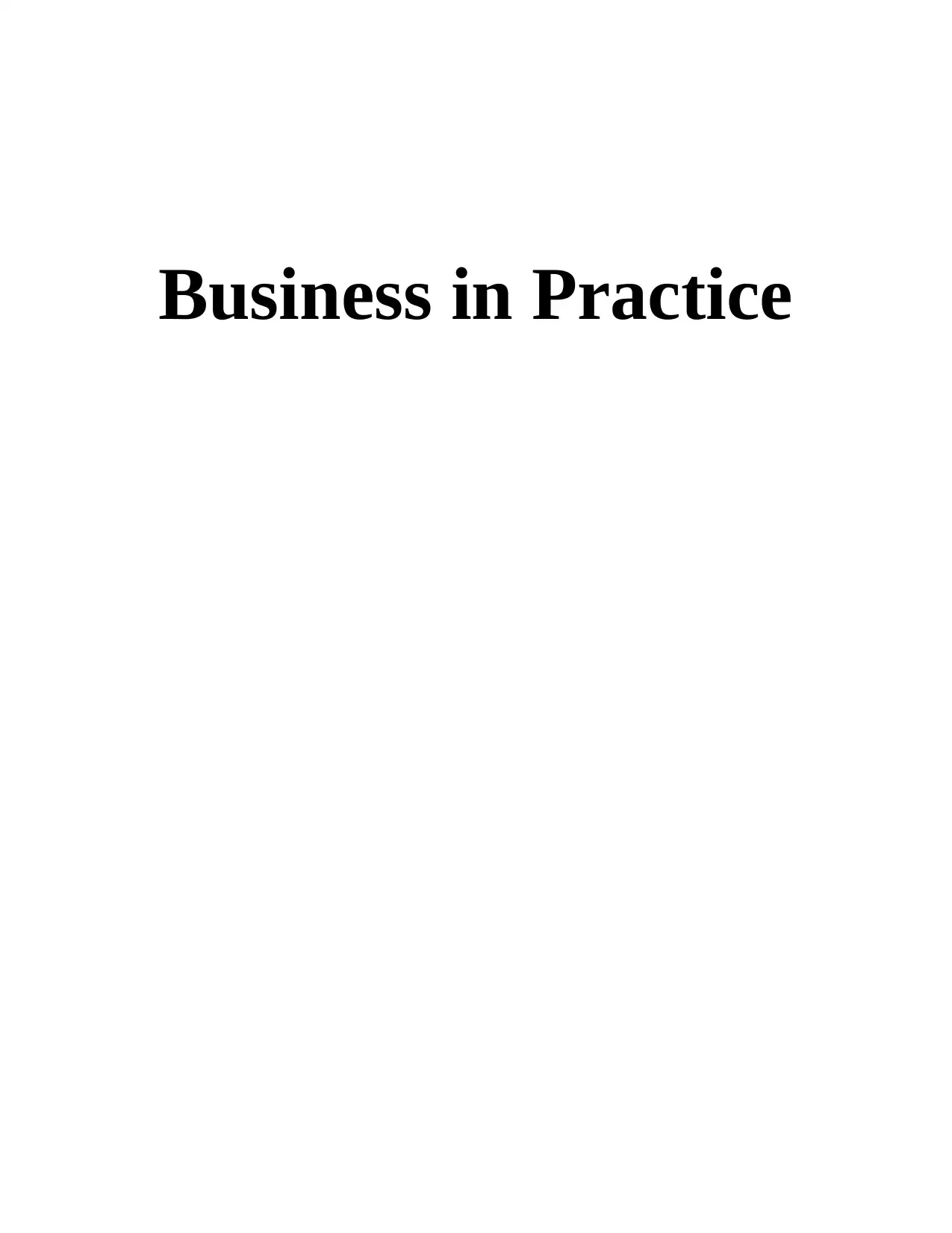
Business in Practice
Paraphrase This Document
Need a fresh take? Get an instant paraphrase of this document with our AI Paraphraser
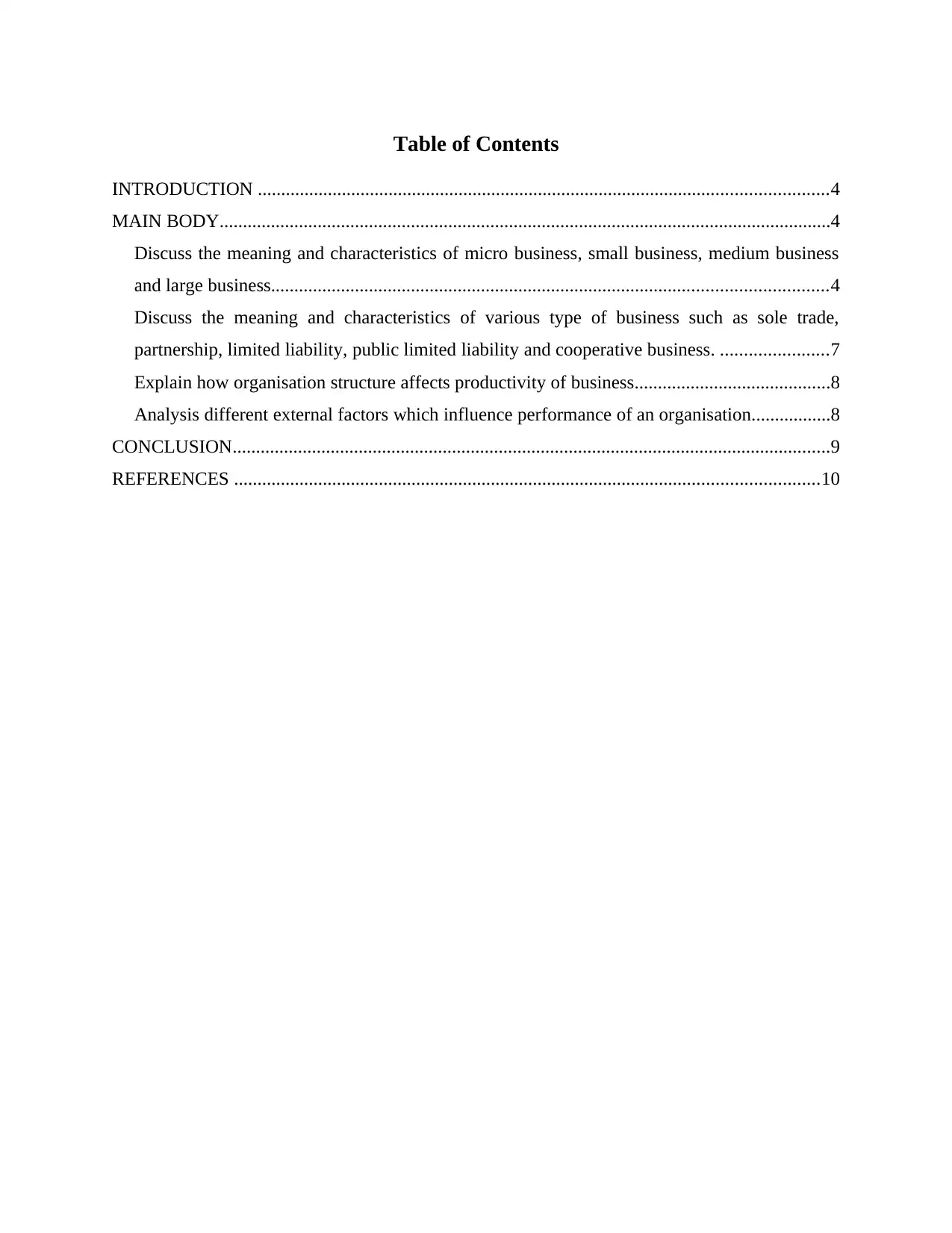
Table of Contents
INTRODUCTION ..........................................................................................................................4
MAIN BODY...................................................................................................................................4
Discuss the meaning and characteristics of micro business, small business, medium business
and large business.......................................................................................................................4
Discuss the meaning and characteristics of various type of business such as sole trade,
partnership, limited liability, public limited liability and cooperative business. .......................7
Explain how organisation structure affects productivity of business..........................................8
Analysis different external factors which influence performance of an organisation.................8
CONCLUSION................................................................................................................................9
REFERENCES .............................................................................................................................10
INTRODUCTION ..........................................................................................................................4
MAIN BODY...................................................................................................................................4
Discuss the meaning and characteristics of micro business, small business, medium business
and large business.......................................................................................................................4
Discuss the meaning and characteristics of various type of business such as sole trade,
partnership, limited liability, public limited liability and cooperative business. .......................7
Explain how organisation structure affects productivity of business..........................................8
Analysis different external factors which influence performance of an organisation.................8
CONCLUSION................................................................................................................................9
REFERENCES .............................................................................................................................10
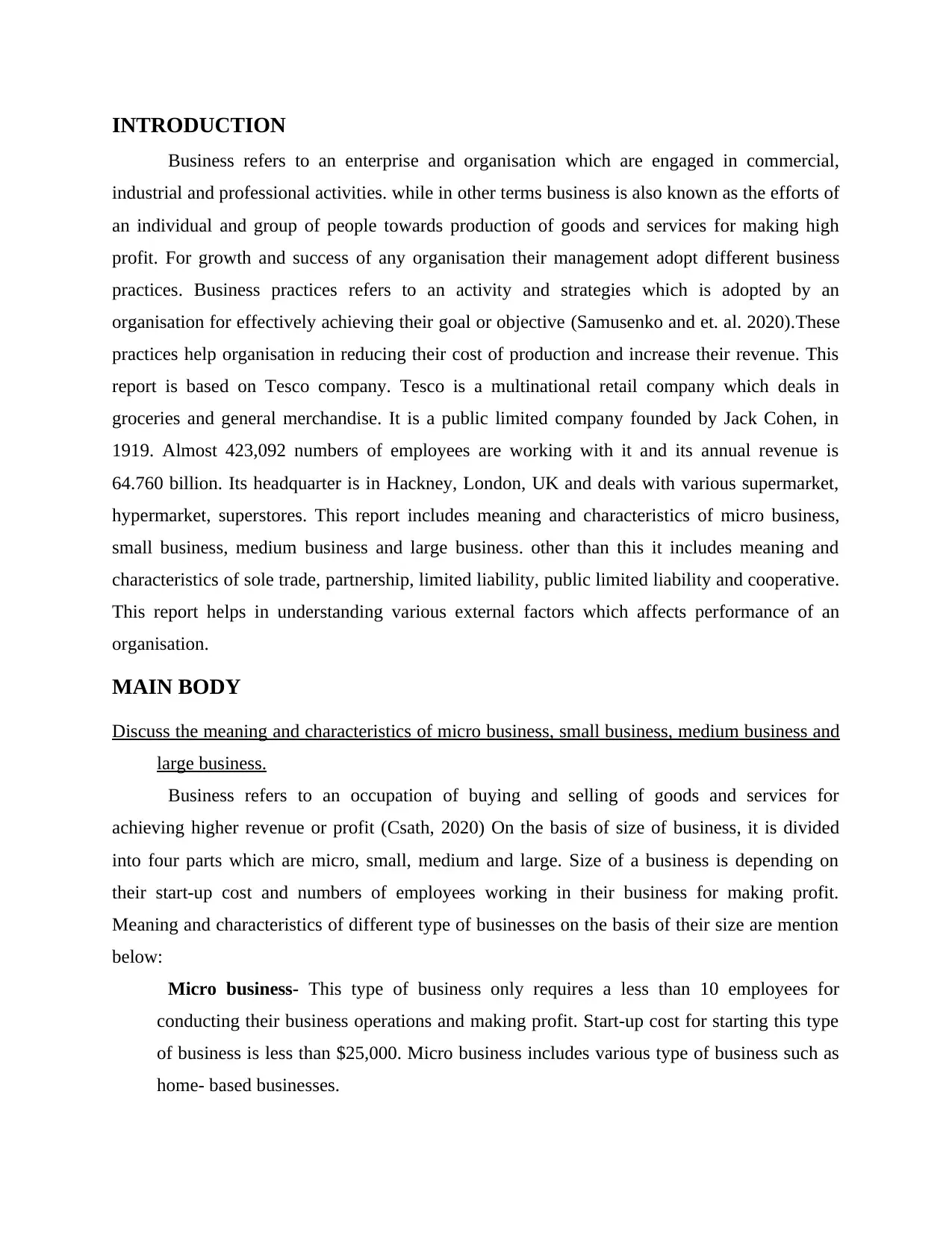
INTRODUCTION
Business refers to an enterprise and organisation which are engaged in commercial,
industrial and professional activities. while in other terms business is also known as the efforts of
an individual and group of people towards production of goods and services for making high
profit. For growth and success of any organisation their management adopt different business
practices. Business practices refers to an activity and strategies which is adopted by an
organisation for effectively achieving their goal or objective (Samusenko and et. al. 2020).These
practices help organisation in reducing their cost of production and increase their revenue. This
report is based on Tesco company. Tesco is a multinational retail company which deals in
groceries and general merchandise. It is a public limited company founded by Jack Cohen, in
1919. Almost 423,092 numbers of employees are working with it and its annual revenue is
64.760 billion. Its headquarter is in Hackney, London, UK and deals with various supermarket,
hypermarket, superstores. This report includes meaning and characteristics of micro business,
small business, medium business and large business. other than this it includes meaning and
characteristics of sole trade, partnership, limited liability, public limited liability and cooperative.
This report helps in understanding various external factors which affects performance of an
organisation.
MAIN BODY
Discuss the meaning and characteristics of micro business, small business, medium business and
large business.
Business refers to an occupation of buying and selling of goods and services for
achieving higher revenue or profit (Csath, 2020) On the basis of size of business, it is divided
into four parts which are micro, small, medium and large. Size of a business is depending on
their start-up cost and numbers of employees working in their business for making profit.
Meaning and characteristics of different type of businesses on the basis of their size are mention
below:
Micro business- This type of business only requires a less than 10 employees for
conducting their business operations and making profit. Start-up cost for starting this type
of business is less than $25,000. Micro business includes various type of business such as
home- based businesses.
Business refers to an enterprise and organisation which are engaged in commercial,
industrial and professional activities. while in other terms business is also known as the efforts of
an individual and group of people towards production of goods and services for making high
profit. For growth and success of any organisation their management adopt different business
practices. Business practices refers to an activity and strategies which is adopted by an
organisation for effectively achieving their goal or objective (Samusenko and et. al. 2020).These
practices help organisation in reducing their cost of production and increase their revenue. This
report is based on Tesco company. Tesco is a multinational retail company which deals in
groceries and general merchandise. It is a public limited company founded by Jack Cohen, in
1919. Almost 423,092 numbers of employees are working with it and its annual revenue is
64.760 billion. Its headquarter is in Hackney, London, UK and deals with various supermarket,
hypermarket, superstores. This report includes meaning and characteristics of micro business,
small business, medium business and large business. other than this it includes meaning and
characteristics of sole trade, partnership, limited liability, public limited liability and cooperative.
This report helps in understanding various external factors which affects performance of an
organisation.
MAIN BODY
Discuss the meaning and characteristics of micro business, small business, medium business and
large business.
Business refers to an occupation of buying and selling of goods and services for
achieving higher revenue or profit (Csath, 2020) On the basis of size of business, it is divided
into four parts which are micro, small, medium and large. Size of a business is depending on
their start-up cost and numbers of employees working in their business for making profit.
Meaning and characteristics of different type of businesses on the basis of their size are mention
below:
Micro business- This type of business only requires a less than 10 employees for
conducting their business operations and making profit. Start-up cost for starting this type
of business is less than $25,000. Micro business includes various type of business such as
home- based businesses.
You're viewing a preview
Unlock full access by subscribing today!
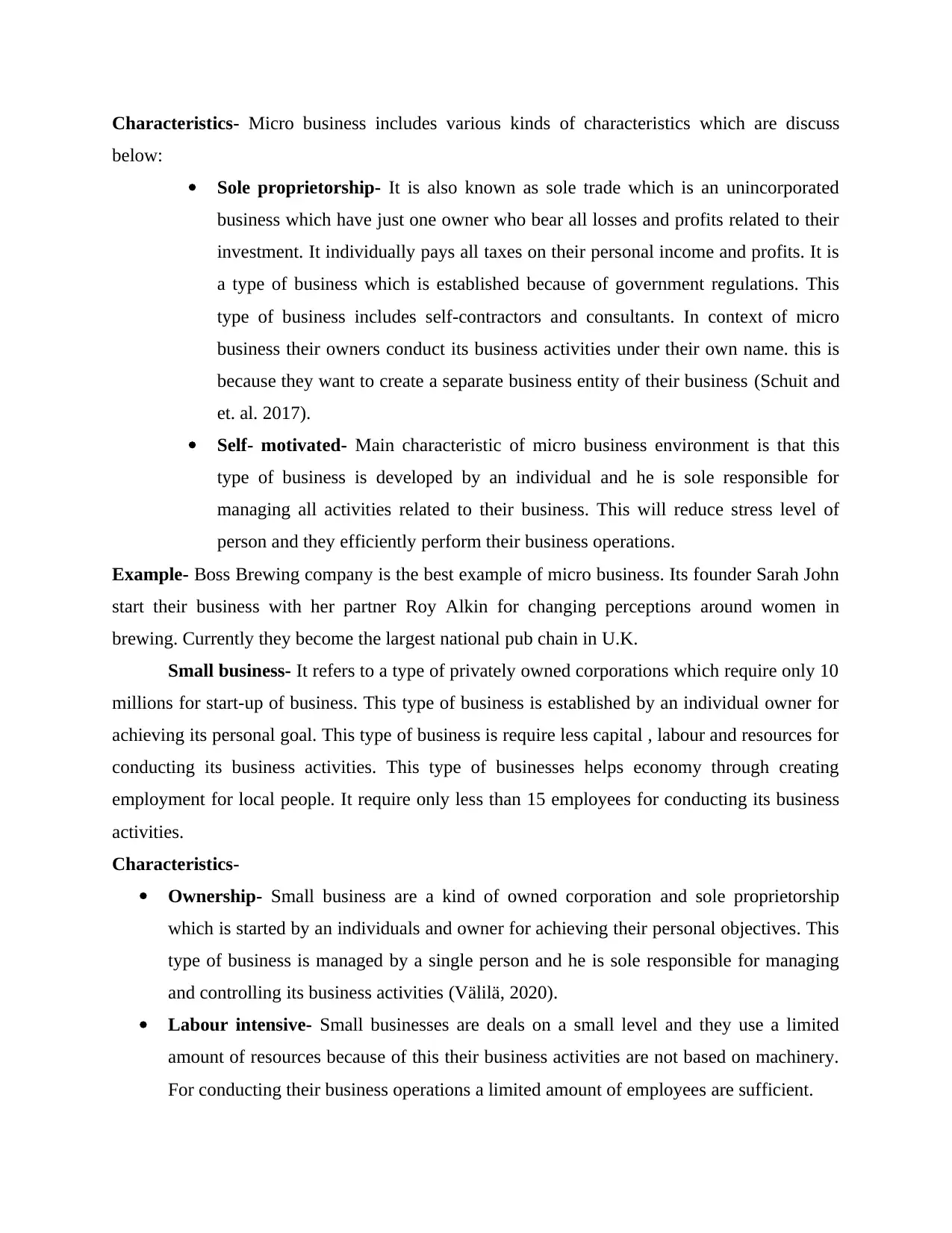
Characteristics- Micro business includes various kinds of characteristics which are discuss
below:
Sole proprietorship- It is also known as sole trade which is an unincorporated
business which have just one owner who bear all losses and profits related to their
investment. It individually pays all taxes on their personal income and profits. It is
a type of business which is established because of government regulations. This
type of business includes self-contractors and consultants. In context of micro
business their owners conduct its business activities under their own name. this is
because they want to create a separate business entity of their business (Schuit and
et. al. 2017).
Self- motivated- Main characteristic of micro business environment is that this
type of business is developed by an individual and he is sole responsible for
managing all activities related to their business. This will reduce stress level of
person and they efficiently perform their business operations.
Example- Boss Brewing company is the best example of micro business. Its founder Sarah John
start their business with her partner Roy Alkin for changing perceptions around women in
brewing. Currently they become the largest national pub chain in U.K.
Small business- It refers to a type of privately owned corporations which require only 10
millions for start-up of business. This type of business is established by an individual owner for
achieving its personal goal. This type of business is require less capital , labour and resources for
conducting its business activities. This type of businesses helps economy through creating
employment for local people. It require only less than 15 employees for conducting its business
activities.
Characteristics-
Ownership- Small business are a kind of owned corporation and sole proprietorship
which is started by an individuals and owner for achieving their personal objectives. This
type of business is managed by a single person and he is sole responsible for managing
and controlling its business activities (Välilä, 2020).
Labour intensive- Small businesses are deals on a small level and they use a limited
amount of resources because of this their business activities are not based on machinery.
For conducting their business operations a limited amount of employees are sufficient.
below:
Sole proprietorship- It is also known as sole trade which is an unincorporated
business which have just one owner who bear all losses and profits related to their
investment. It individually pays all taxes on their personal income and profits. It is
a type of business which is established because of government regulations. This
type of business includes self-contractors and consultants. In context of micro
business their owners conduct its business activities under their own name. this is
because they want to create a separate business entity of their business (Schuit and
et. al. 2017).
Self- motivated- Main characteristic of micro business environment is that this
type of business is developed by an individual and he is sole responsible for
managing all activities related to their business. This will reduce stress level of
person and they efficiently perform their business operations.
Example- Boss Brewing company is the best example of micro business. Its founder Sarah John
start their business with her partner Roy Alkin for changing perceptions around women in
brewing. Currently they become the largest national pub chain in U.K.
Small business- It refers to a type of privately owned corporations which require only 10
millions for start-up of business. This type of business is established by an individual owner for
achieving its personal goal. This type of business is require less capital , labour and resources for
conducting its business activities. This type of businesses helps economy through creating
employment for local people. It require only less than 15 employees for conducting its business
activities.
Characteristics-
Ownership- Small business are a kind of owned corporation and sole proprietorship
which is started by an individuals and owner for achieving their personal objectives. This
type of business is managed by a single person and he is sole responsible for managing
and controlling its business activities (Välilä, 2020).
Labour intensive- Small businesses are deals on a small level and they use a limited
amount of resources because of this their business activities are not based on machinery.
For conducting their business operations a limited amount of employees are sufficient.
Paraphrase This Document
Need a fresh take? Get an instant paraphrase of this document with our AI Paraphraser
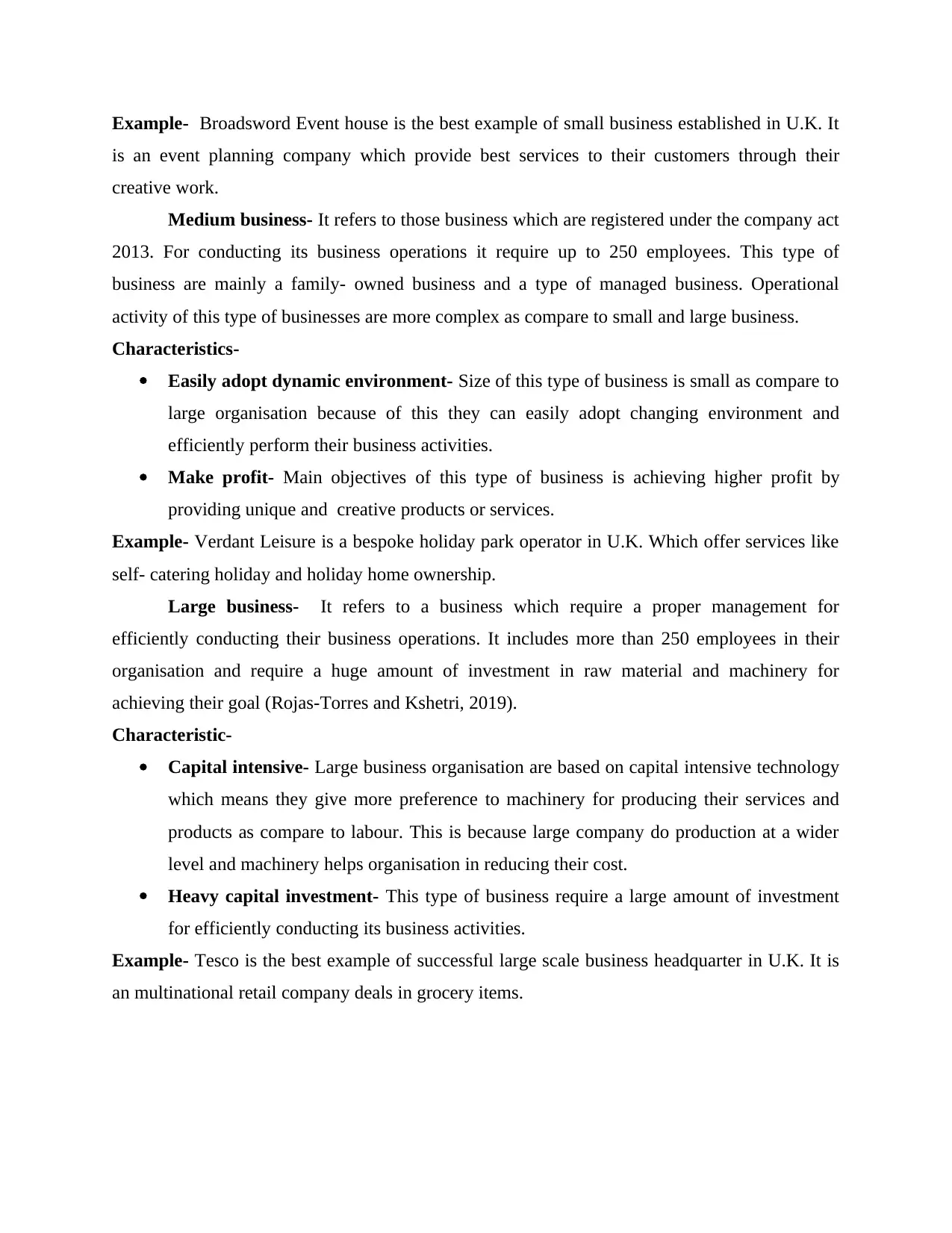
Example- Broadsword Event house is the best example of small business established in U.K. It
is an event planning company which provide best services to their customers through their
creative work.
Medium business- It refers to those business which are registered under the company act
2013. For conducting its business operations it require up to 250 employees. This type of
business are mainly a family- owned business and a type of managed business. Operational
activity of this type of businesses are more complex as compare to small and large business.
Characteristics-
Easily adopt dynamic environment- Size of this type of business is small as compare to
large organisation because of this they can easily adopt changing environment and
efficiently perform their business activities.
Make profit- Main objectives of this type of business is achieving higher profit by
providing unique and creative products or services.
Example- Verdant Leisure is a bespoke holiday park operator in U.K. Which offer services like
self- catering holiday and holiday home ownership.
Large business- It refers to a business which require a proper management for
efficiently conducting their business operations. It includes more than 250 employees in their
organisation and require a huge amount of investment in raw material and machinery for
achieving their goal (Rojas-Torres and Kshetri, 2019).
Characteristic-
Capital intensive- Large business organisation are based on capital intensive technology
which means they give more preference to machinery for producing their services and
products as compare to labour. This is because large company do production at a wider
level and machinery helps organisation in reducing their cost.
Heavy capital investment- This type of business require a large amount of investment
for efficiently conducting its business activities.
Example- Tesco is the best example of successful large scale business headquarter in U.K. It is
an multinational retail company deals in grocery items.
is an event planning company which provide best services to their customers through their
creative work.
Medium business- It refers to those business which are registered under the company act
2013. For conducting its business operations it require up to 250 employees. This type of
business are mainly a family- owned business and a type of managed business. Operational
activity of this type of businesses are more complex as compare to small and large business.
Characteristics-
Easily adopt dynamic environment- Size of this type of business is small as compare to
large organisation because of this they can easily adopt changing environment and
efficiently perform their business activities.
Make profit- Main objectives of this type of business is achieving higher profit by
providing unique and creative products or services.
Example- Verdant Leisure is a bespoke holiday park operator in U.K. Which offer services like
self- catering holiday and holiday home ownership.
Large business- It refers to a business which require a proper management for
efficiently conducting their business operations. It includes more than 250 employees in their
organisation and require a huge amount of investment in raw material and machinery for
achieving their goal (Rojas-Torres and Kshetri, 2019).
Characteristic-
Capital intensive- Large business organisation are based on capital intensive technology
which means they give more preference to machinery for producing their services and
products as compare to labour. This is because large company do production at a wider
level and machinery helps organisation in reducing their cost.
Heavy capital investment- This type of business require a large amount of investment
for efficiently conducting its business activities.
Example- Tesco is the best example of successful large scale business headquarter in U.K. It is
an multinational retail company deals in grocery items.
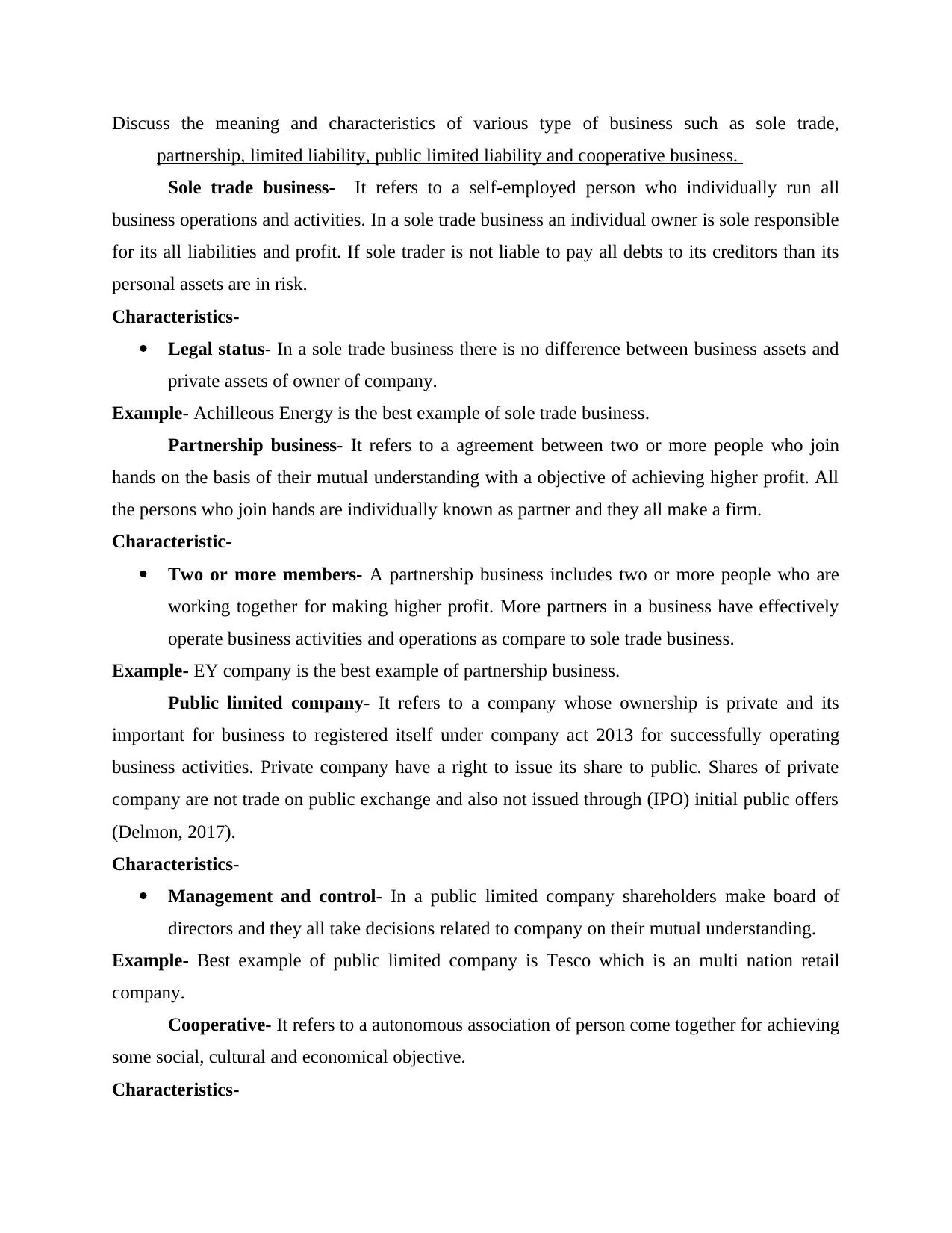
Discuss the meaning and characteristics of various type of business such as sole trade,
partnership, limited liability, public limited liability and cooperative business.
Sole trade business- It refers to a self-employed person who individually run all
business operations and activities. In a sole trade business an individual owner is sole responsible
for its all liabilities and profit. If sole trader is not liable to pay all debts to its creditors than its
personal assets are in risk.
Characteristics-
Legal status- In a sole trade business there is no difference between business assets and
private assets of owner of company.
Example- Achilleous Energy is the best example of sole trade business.
Partnership business- It refers to a agreement between two or more people who join
hands on the basis of their mutual understanding with a objective of achieving higher profit. All
the persons who join hands are individually known as partner and they all make a firm.
Characteristic-
Two or more members- A partnership business includes two or more people who are
working together for making higher profit. More partners in a business have effectively
operate business activities and operations as compare to sole trade business.
Example- EY company is the best example of partnership business.
Public limited company- It refers to a company whose ownership is private and its
important for business to registered itself under company act 2013 for successfully operating
business activities. Private company have a right to issue its share to public. Shares of private
company are not trade on public exchange and also not issued through (IPO) initial public offers
(Delmon, 2017).
Characteristics-
Management and control- In a public limited company shareholders make board of
directors and they all take decisions related to company on their mutual understanding.
Example- Best example of public limited company is Tesco which is an multi nation retail
company.
Cooperative- It refers to a autonomous association of person come together for achieving
some social, cultural and economical objective.
Characteristics-
partnership, limited liability, public limited liability and cooperative business.
Sole trade business- It refers to a self-employed person who individually run all
business operations and activities. In a sole trade business an individual owner is sole responsible
for its all liabilities and profit. If sole trader is not liable to pay all debts to its creditors than its
personal assets are in risk.
Characteristics-
Legal status- In a sole trade business there is no difference between business assets and
private assets of owner of company.
Example- Achilleous Energy is the best example of sole trade business.
Partnership business- It refers to a agreement between two or more people who join
hands on the basis of their mutual understanding with a objective of achieving higher profit. All
the persons who join hands are individually known as partner and they all make a firm.
Characteristic-
Two or more members- A partnership business includes two or more people who are
working together for making higher profit. More partners in a business have effectively
operate business activities and operations as compare to sole trade business.
Example- EY company is the best example of partnership business.
Public limited company- It refers to a company whose ownership is private and its
important for business to registered itself under company act 2013 for successfully operating
business activities. Private company have a right to issue its share to public. Shares of private
company are not trade on public exchange and also not issued through (IPO) initial public offers
(Delmon, 2017).
Characteristics-
Management and control- In a public limited company shareholders make board of
directors and they all take decisions related to company on their mutual understanding.
Example- Best example of public limited company is Tesco which is an multi nation retail
company.
Cooperative- It refers to a autonomous association of person come together for achieving
some social, cultural and economical objective.
Characteristics-
You're viewing a preview
Unlock full access by subscribing today!
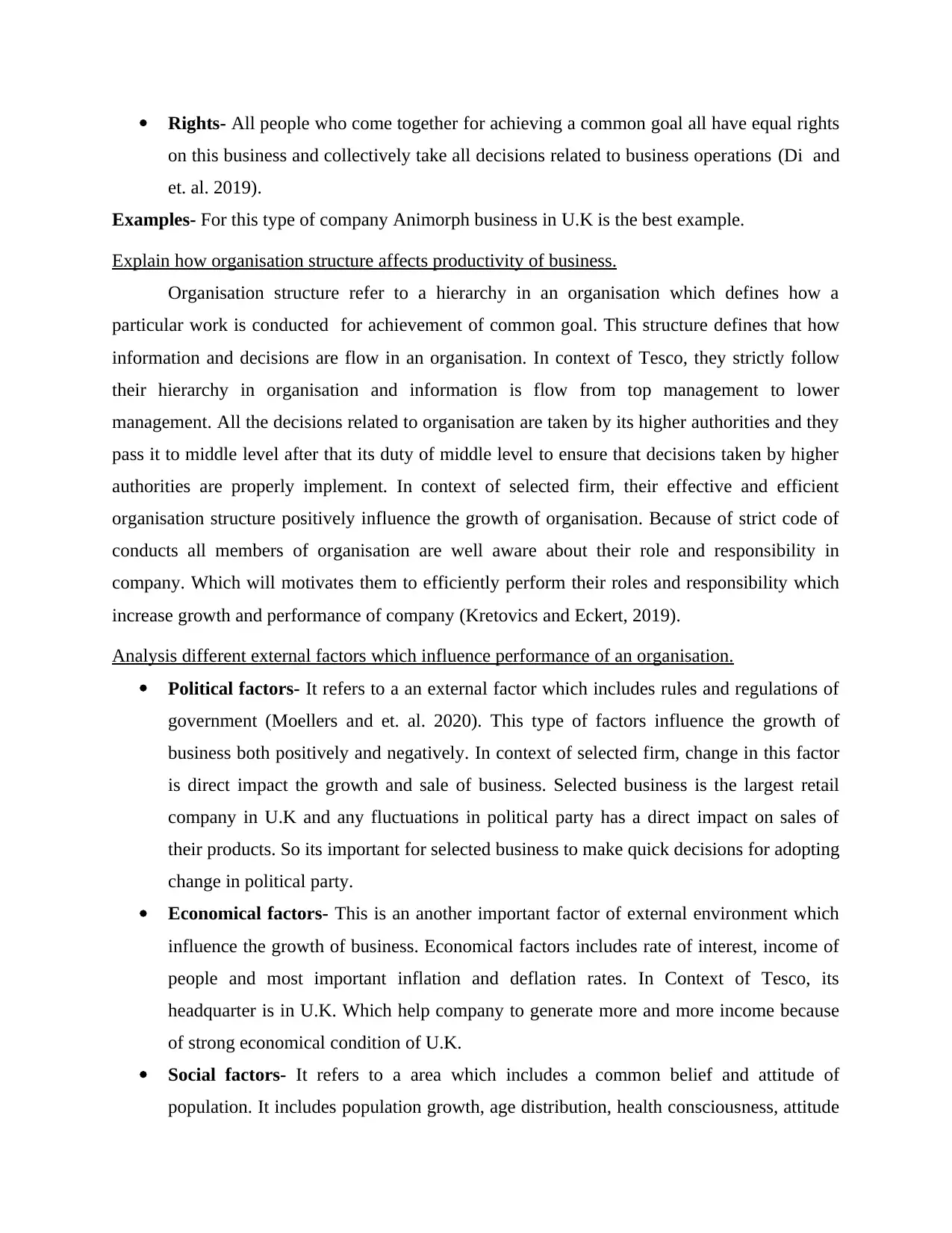
Rights- All people who come together for achieving a common goal all have equal rights
on this business and collectively take all decisions related to business operations (Di and
et. al. 2019).
Examples- For this type of company Animorph business in U.K is the best example.
Explain how organisation structure affects productivity of business.
Organisation structure refer to a hierarchy in an organisation which defines how a
particular work is conducted for achievement of common goal. This structure defines that how
information and decisions are flow in an organisation. In context of Tesco, they strictly follow
their hierarchy in organisation and information is flow from top management to lower
management. All the decisions related to organisation are taken by its higher authorities and they
pass it to middle level after that its duty of middle level to ensure that decisions taken by higher
authorities are properly implement. In context of selected firm, their effective and efficient
organisation structure positively influence the growth of organisation. Because of strict code of
conducts all members of organisation are well aware about their role and responsibility in
company. Which will motivates them to efficiently perform their roles and responsibility which
increase growth and performance of company (Kretovics and Eckert, 2019).
Analysis different external factors which influence performance of an organisation.
Political factors- It refers to a an external factor which includes rules and regulations of
government (Moellers and et. al. 2020). This type of factors influence the growth of
business both positively and negatively. In context of selected firm, change in this factor
is direct impact the growth and sale of business. Selected business is the largest retail
company in U.K and any fluctuations in political party has a direct impact on sales of
their products. So its important for selected business to make quick decisions for adopting
change in political party.
Economical factors- This is an another important factor of external environment which
influence the growth of business. Economical factors includes rate of interest, income of
people and most important inflation and deflation rates. In Context of Tesco, its
headquarter is in U.K. Which help company to generate more and more income because
of strong economical condition of U.K.
Social factors- It refers to a area which includes a common belief and attitude of
population. It includes population growth, age distribution, health consciousness, attitude
on this business and collectively take all decisions related to business operations (Di and
et. al. 2019).
Examples- For this type of company Animorph business in U.K is the best example.
Explain how organisation structure affects productivity of business.
Organisation structure refer to a hierarchy in an organisation which defines how a
particular work is conducted for achievement of common goal. This structure defines that how
information and decisions are flow in an organisation. In context of Tesco, they strictly follow
their hierarchy in organisation and information is flow from top management to lower
management. All the decisions related to organisation are taken by its higher authorities and they
pass it to middle level after that its duty of middle level to ensure that decisions taken by higher
authorities are properly implement. In context of selected firm, their effective and efficient
organisation structure positively influence the growth of organisation. Because of strict code of
conducts all members of organisation are well aware about their role and responsibility in
company. Which will motivates them to efficiently perform their roles and responsibility which
increase growth and performance of company (Kretovics and Eckert, 2019).
Analysis different external factors which influence performance of an organisation.
Political factors- It refers to a an external factor which includes rules and regulations of
government (Moellers and et. al. 2020). This type of factors influence the growth of
business both positively and negatively. In context of selected firm, change in this factor
is direct impact the growth and sale of business. Selected business is the largest retail
company in U.K and any fluctuations in political party has a direct impact on sales of
their products. So its important for selected business to make quick decisions for adopting
change in political party.
Economical factors- This is an another important factor of external environment which
influence the growth of business. Economical factors includes rate of interest, income of
people and most important inflation and deflation rates. In Context of Tesco, its
headquarter is in U.K. Which help company to generate more and more income because
of strong economical condition of U.K.
Social factors- It refers to a area which includes a common belief and attitude of
population. It includes population growth, age distribution, health consciousness, attitude
Paraphrase This Document
Need a fresh take? Get an instant paraphrase of this document with our AI Paraphraser
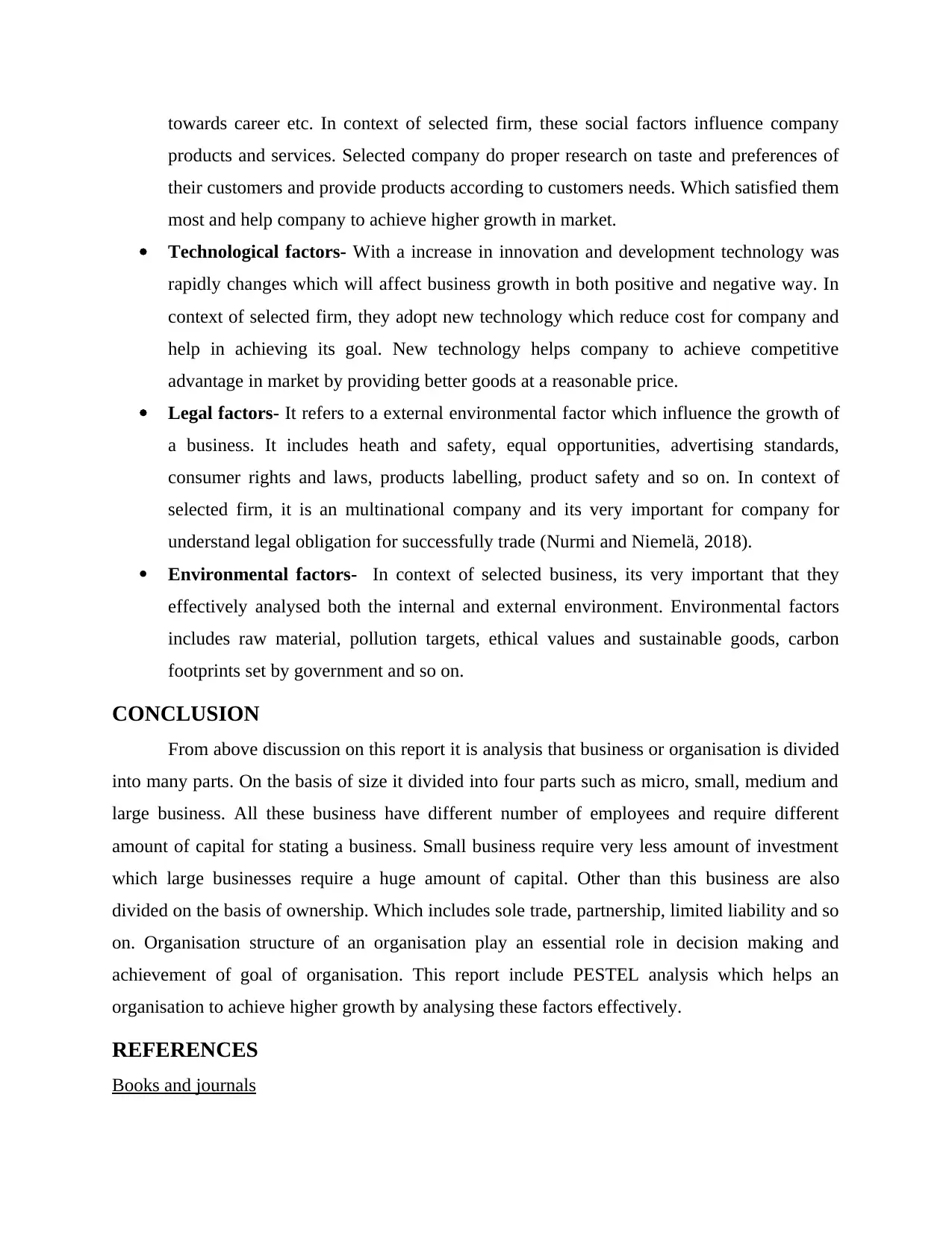
towards career etc. In context of selected firm, these social factors influence company
products and services. Selected company do proper research on taste and preferences of
their customers and provide products according to customers needs. Which satisfied them
most and help company to achieve higher growth in market.
Technological factors- With a increase in innovation and development technology was
rapidly changes which will affect business growth in both positive and negative way. In
context of selected firm, they adopt new technology which reduce cost for company and
help in achieving its goal. New technology helps company to achieve competitive
advantage in market by providing better goods at a reasonable price.
Legal factors- It refers to a external environmental factor which influence the growth of
a business. It includes heath and safety, equal opportunities, advertising standards,
consumer rights and laws, products labelling, product safety and so on. In context of
selected firm, it is an multinational company and its very important for company for
understand legal obligation for successfully trade (Nurmi and Niemelä, 2018).
Environmental factors- In context of selected business, its very important that they
effectively analysed both the internal and external environment. Environmental factors
includes raw material, pollution targets, ethical values and sustainable goods, carbon
footprints set by government and so on.
CONCLUSION
From above discussion on this report it is analysis that business or organisation is divided
into many parts. On the basis of size it divided into four parts such as micro, small, medium and
large business. All these business have different number of employees and require different
amount of capital for stating a business. Small business require very less amount of investment
which large businesses require a huge amount of capital. Other than this business are also
divided on the basis of ownership. Which includes sole trade, partnership, limited liability and so
on. Organisation structure of an organisation play an essential role in decision making and
achievement of goal of organisation. This report include PESTEL analysis which helps an
organisation to achieve higher growth by analysing these factors effectively.
REFERENCES
Books and journals
products and services. Selected company do proper research on taste and preferences of
their customers and provide products according to customers needs. Which satisfied them
most and help company to achieve higher growth in market.
Technological factors- With a increase in innovation and development technology was
rapidly changes which will affect business growth in both positive and negative way. In
context of selected firm, they adopt new technology which reduce cost for company and
help in achieving its goal. New technology helps company to achieve competitive
advantage in market by providing better goods at a reasonable price.
Legal factors- It refers to a external environmental factor which influence the growth of
a business. It includes heath and safety, equal opportunities, advertising standards,
consumer rights and laws, products labelling, product safety and so on. In context of
selected firm, it is an multinational company and its very important for company for
understand legal obligation for successfully trade (Nurmi and Niemelä, 2018).
Environmental factors- In context of selected business, its very important that they
effectively analysed both the internal and external environment. Environmental factors
includes raw material, pollution targets, ethical values and sustainable goods, carbon
footprints set by government and so on.
CONCLUSION
From above discussion on this report it is analysis that business or organisation is divided
into many parts. On the basis of size it divided into four parts such as micro, small, medium and
large business. All these business have different number of employees and require different
amount of capital for stating a business. Small business require very less amount of investment
which large businesses require a huge amount of capital. Other than this business are also
divided on the basis of ownership. Which includes sole trade, partnership, limited liability and so
on. Organisation structure of an organisation play an essential role in decision making and
achievement of goal of organisation. This report include PESTEL analysis which helps an
organisation to achieve higher growth by analysing these factors effectively.
REFERENCES
Books and journals
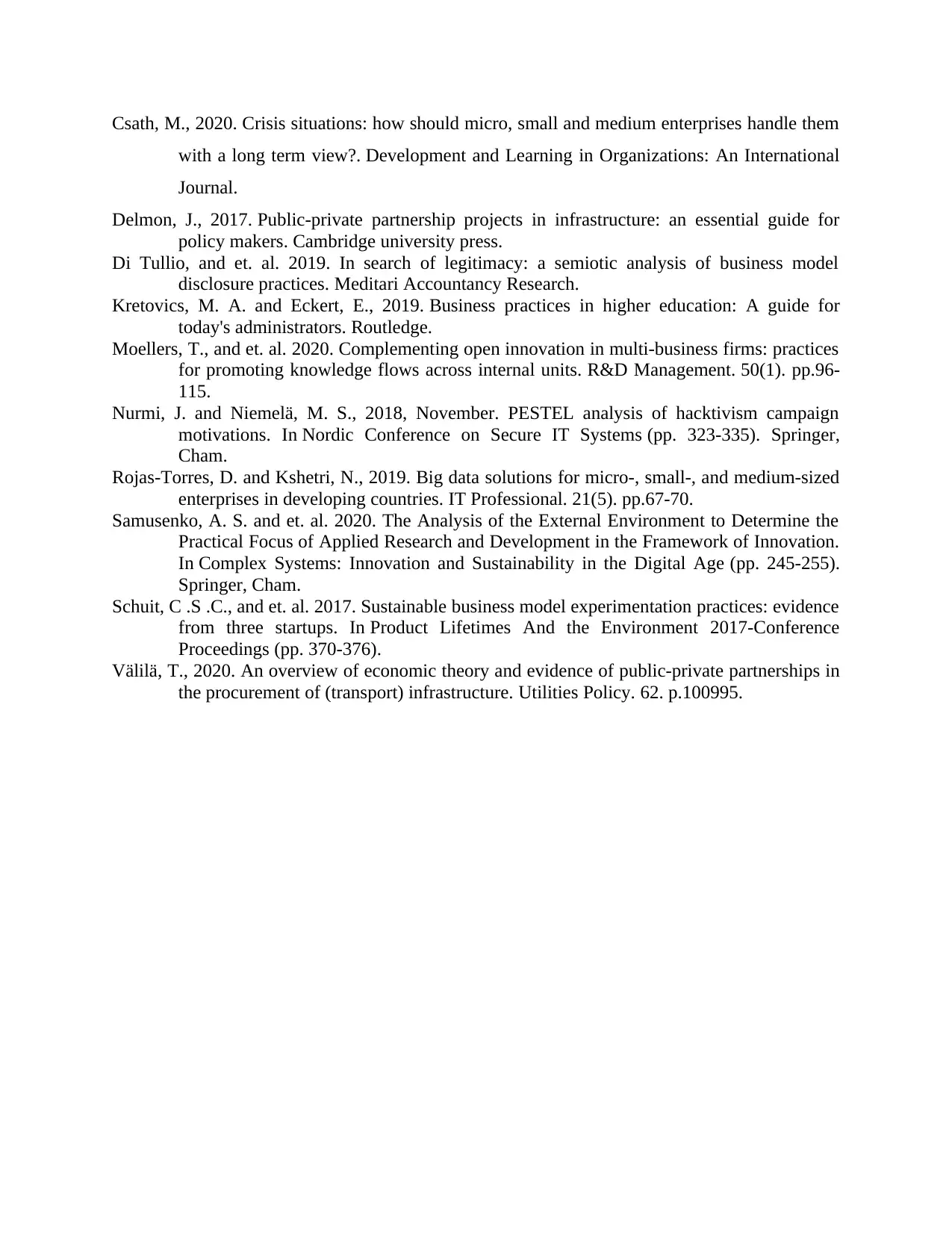
Csath, M., 2020. Crisis situations: how should micro, small and medium enterprises handle them
with a long term view?. Development and Learning in Organizations: An International
Journal.
Delmon, J., 2017. Public-private partnership projects in infrastructure: an essential guide for
policy makers. Cambridge university press.
Di Tullio, and et. al. 2019. In search of legitimacy: a semiotic analysis of business model
disclosure practices. Meditari Accountancy Research.
Kretovics, M. A. and Eckert, E., 2019. Business practices in higher education: A guide for
today's administrators. Routledge.
Moellers, T., and et. al. 2020. Complementing open innovation in multi‐business firms: practices
for promoting knowledge flows across internal units. R&D Management. 50(1). pp.96-
115.
Nurmi, J. and Niemelä, M. S., 2018, November. PESTEL analysis of hacktivism campaign
motivations. In Nordic Conference on Secure IT Systems (pp. 323-335). Springer,
Cham.
Rojas-Torres, D. and Kshetri, N., 2019. Big data solutions for micro-, small-, and medium-sized
enterprises in developing countries. IT Professional. 21(5). pp.67-70.
Samusenko, A. S. and et. al. 2020. The Analysis of the External Environment to Determine the
Practical Focus of Applied Research and Development in the Framework of Innovation.
In Complex Systems: Innovation and Sustainability in the Digital Age (pp. 245-255).
Springer, Cham.
Schuit, C .S .C., and et. al. 2017. Sustainable business model experimentation practices: evidence
from three startups. In Product Lifetimes And the Environment 2017-Conference
Proceedings (pp. 370-376).
Välilä, T., 2020. An overview of economic theory and evidence of public-private partnerships in
the procurement of (transport) infrastructure. Utilities Policy. 62. p.100995.
with a long term view?. Development and Learning in Organizations: An International
Journal.
Delmon, J., 2017. Public-private partnership projects in infrastructure: an essential guide for
policy makers. Cambridge university press.
Di Tullio, and et. al. 2019. In search of legitimacy: a semiotic analysis of business model
disclosure practices. Meditari Accountancy Research.
Kretovics, M. A. and Eckert, E., 2019. Business practices in higher education: A guide for
today's administrators. Routledge.
Moellers, T., and et. al. 2020. Complementing open innovation in multi‐business firms: practices
for promoting knowledge flows across internal units. R&D Management. 50(1). pp.96-
115.
Nurmi, J. and Niemelä, M. S., 2018, November. PESTEL analysis of hacktivism campaign
motivations. In Nordic Conference on Secure IT Systems (pp. 323-335). Springer,
Cham.
Rojas-Torres, D. and Kshetri, N., 2019. Big data solutions for micro-, small-, and medium-sized
enterprises in developing countries. IT Professional. 21(5). pp.67-70.
Samusenko, A. S. and et. al. 2020. The Analysis of the External Environment to Determine the
Practical Focus of Applied Research and Development in the Framework of Innovation.
In Complex Systems: Innovation and Sustainability in the Digital Age (pp. 245-255).
Springer, Cham.
Schuit, C .S .C., and et. al. 2017. Sustainable business model experimentation practices: evidence
from three startups. In Product Lifetimes And the Environment 2017-Conference
Proceedings (pp. 370-376).
Välilä, T., 2020. An overview of economic theory and evidence of public-private partnerships in
the procurement of (transport) infrastructure. Utilities Policy. 62. p.100995.
You're viewing a preview
Unlock full access by subscribing today!
1 out of 9
Related Documents
Your All-in-One AI-Powered Toolkit for Academic Success.
+13062052269
info@desklib.com
Available 24*7 on WhatsApp / Email
![[object Object]](/_next/static/media/star-bottom.7253800d.svg)
Unlock your academic potential
© 2024 | Zucol Services PVT LTD | All rights reserved.





